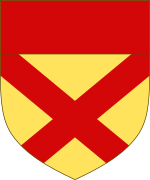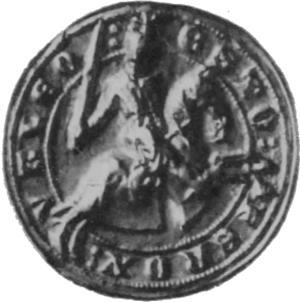Robert de Brus, 5th Lord of Annandale facts for kids
Quick facts for kids
Robert V de Brus
|
|
|---|---|
| Lord of Annandale, Lord of Ireby, Constable of Carlisle Castle, Sheriff of Cumberland | |

Coat of arms as Lord of Annandale: Or, a saltire and a chief Gules
|
|
| Predecessor | Robert de Brus, 4th Lord of Annandale |
| Successor | Robert de Brus, 6th Lord of Annandale |
| Born | ca. 1215 |
| Died | 31 March 1295 (aged ~80) Lochmaben Castle |
| Buried | Gisborough Priory, Guisborough, Redcar and Cleveland |
| Spouse(s) | Isabella of Gloucester and Hertford Christina de Ireby |
| Issue | Robert de Brus Richard de Brus |
| Father | Robert de Brus, 4th Lord of Annandale |
| Mother | Isobel of Huntingdon |
Robert V de Brus (also known as Robert de Brus), was the 5th Lord of Annandale. He was born around 1215 and passed away on March 31 or May 3, 1295. Robert was an important noble, a judge, and a castle commander in both Scotland and England. He even served as a regent (a temporary ruler) of Scotland. He is often called "Robert the Competitor" because he was one of the main people who wanted to become King of Scotland in 1290-1292. His grandson, Robert the Bruce, later became the famous King of Scots.
Contents
Robert's Life and Times
Growing Up and Family Connections
Robert was the son of Robert Bruce, 4th Lord of Annandale and Isobel of Huntingdon. He was also the grandson of David of Scotland, 8th Earl of Huntingdon. This made him a great-grandson of Henry of Scotland, and a great-great-grandson of King David I of Scotland. His family had strong ties to the Scottish royal line.
Lands and Power
Besides Annandale in Scotland, Robert owned lands in England. These included Hartlepool in County Durham and Writtle in Essex. His first wife, Isabella, brought him the village of Ripe in Sussex. His second wife, Christina, added the Lordship of Ireby in Cumberland to his family's lands.
Robert's power grew after a big battle called the Battle of Evesham in 1265. He received more lands from King Henry III of England. The King also made him a judge again and put him in charge of Carlisle Castle in 1267. This was a job he had lost earlier. Robert may have joined Prince Edward on a religious journey called a crusade around this time.
Marriages and Children
In 1271 or 1272, Robert helped his son, also named Robert de Brus, marry Marjorie of Carrick. She was a young widow and the heir to the Earldom of Carrick. Around this time, Robert's first wife, Isabella de Clare, passed away.
On May 3, 1273, Robert married Christina de Ireby. She was a widow who owned lands in Cumberland. After this marriage, Robert focused on managing his family's lands in the north. He let his sons manage the lands further south.
Serving Scotland as Regent
Robert Bruce was a regent of Scotland for a while when his second cousin, King Alexander III of Scotland, was still a child. A regent is someone who rules when the king is too young or unable to. Robert was the closest male relative to the King. When King Alexander had no children for a time, Robert was officially named as the next in line to the throne. However, King Alexander later had three children, so Robert did not become king then.
Sadly, all three of King Alexander's children died within a few years. In 1284, King Alexander made the Scottish Parliament agree that his granddaughter, Margaret, would be his heir. She was called the "Maid of Norway" because she lived there.
King Alexander married again in 1285, hoping for a male heir. But he died suddenly in 1286 after falling from his horse. He was only 45 years old. His death caused a lot of trouble in Scotland. His three-year-old granddaughter Margaret was recognized as the new queen. But she died on the Orkney islands in 1290 while traveling to Scotland. With her death, the main royal family line ended. This led to many people claiming they should be the next King of Scotland.
The Great Cause: Who Would Be King?
After the royal family line ended, the descendants of David of Huntingdon were the main people who wanted to be king. The two most important claimants were John Balliol and Robert Bruce himself. John Balliol was descended from David's oldest daughter, while Robert Bruce was descended from David's second daughter.
Robert Bruce argued that he should be king because he was closer in blood to the previous kings. He was a second cousin to the kings of Scotland. John Balliol was a third cousin. This big argument over who should be king was called the 'Great Cause'. In 1292, the decision was made. The crown of Scotland went to John Balliol, who was a big rival of the Bruce family. Here's how it happened:
After young Queen Margaret died, Robert Bruce gathered some men and marched towards Perth. Bishop William Fraser of St. Andrews was worried about a civil war. He wrote to King Edward I of England, asking for his help to choose a new king.
King Edward saw this as a chance to gain power over Scotland. He said he would help decide, but only if Scotland recognized him as their overlord. The Scottish guardians (who were ruling the country) did not want to agree. But Robert Bruce quickly agreed to show respect to Edward. All the people claiming the throne swore loyalty to Edward, with John Balliol being the last.
The decision took a long time. In August 1291, Edward asked Balliol and Bruce to each choose 40 people to help decide the case. Edward himself chose 24 people. After looking at all the arguments, in November 1292, the court chose John Balliol. He had a stronger claim based on feudal law and more support in Scotland. Edward made the final decision on November 17. On November 30, John Balliol was crowned King of Scots. On December 26, King John swore loyalty to Edward for the kingdom of Scotland. Edward then made it clear that he saw Scotland as a country under his control. The Bruce family felt they had lost their rightful place on the Scottish throne.
Later Years and Legacy
After losing the claim to the throne, Robert, the 5th Lord of Annandale, gave up his lordship of Annandale and his claim to the throne to his oldest son, also named Robert de Brus. Soon after, in 1292, the younger Robert's wife, Marjorie of Carrick, died. The Earldom of Carrick then passed to their oldest son, who was also named Robert. This Robert would later become the famous King of Scotland.
In 1292, Robert V de Brus held a market in Ireby, Cumberland. The next year, he held a market in Hartlepool, County Durham.
Sir Robert de Brus passed away at Lochmaben Castle. He was buried at Gisborough Priory in Cleveland, England.
Family Members
Robert first married Lady Isabella de Clare on May 12, 1240. She was born in 1226 and passed away after 1264. They had several children:
- Isabel de Brus (born 1249, died around 1284).
- Robert VI de Bruce, 6th Lord of Annandale, Earl of Carrick (born 1243, died 1304). He was the father of Robert the Bruce, the future King of Scots.
- William de Brus.
- John de Brus (died 1275).
- Richard de Brus (died around January 26, 1287).
He married a second time on May 3, 1275, to Christina de Ireby. She was the daughter of Sir William de Ireby. They did not have any children together.
See also


